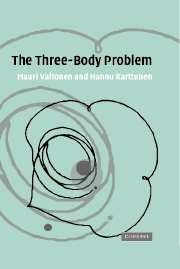Book contents
- Frontmatter
- Contents
- Preface
- 1 Astrophysics and the three-body problem
- 2 Newtonian mechanics
- 3 The two-body problem
- 4 Hamiltonian mechanics
- 5 The planar restricted circular three-body problem and other special cases
- 6 Three-body scattering
- 7 Escape in the general three-body problem
- 8 Scattering and capture in the general problem
- 9 Perturbations in hierarchical systems
- 10 Perturbations in strong three-body encounters
- 11 Some astrophysical problems
- References
- Author index
- Subject index
2 - Newtonian mechanics
Published online by Cambridge University Press: 04 December 2009
- Frontmatter
- Contents
- Preface
- 1 Astrophysics and the three-body problem
- 2 Newtonian mechanics
- 3 The two-body problem
- 4 Hamiltonian mechanics
- 5 The planar restricted circular three-body problem and other special cases
- 6 Three-body scattering
- 7 Escape in the general three-body problem
- 8 Scattering and capture in the general problem
- 9 Perturbations in hierarchical systems
- 10 Perturbations in strong three-body encounters
- 11 Some astrophysical problems
- References
- Author index
- Subject index
Summary
This chapter introduces the basic concepts of Newtonian mechanics. We will emphasize the areas which are most useful in the three-body problem, and also familiarise ourselves with a system of units and scaling laws. The calculation of orbits using Newton's laws is a central theme of this book, and therefore a brief introduction to the methods follows. It is not the purpose of this work to teach the latest orbit calculation techniques; therefore only a brief introduction is given. Finally, we discuss the connection of Newtonian mechanics to chaos. It may come as a surprise that the introduction of just one more body to the well behaved two-body system brings about a chaotic, unpredictable dynamical system. This was realised by Poincaré well before the concept of deterministic chaos became a popular topic.
Newton's laws
We begin with the fundamental laws of mechanics, as given by Newton in his Principia in 1687, although in a more modern form.
First law If there are no external forces, an object will maintain its state of motion, i.e. it will stay at rest or continue rectilinear motion at constant velocity.
Second law The rate of change of the momentum of an object is proportional to the applied force.
- Type
- Chapter
- Information
- The Three-Body Problem , pp. 20 - 46Publisher: Cambridge University PressPrint publication year: 2006



